
 |
|
|
#1 |
|
Member
Join Date: Jun 2006
Location: Arabia
Posts: 278
|
Hello,
This is the next section of coverage of my trip. This place is called 'souk al-zal', literally, the carpets market. However, not only rugs, but traditional clothes, and antiques are sold there, including swords. There are about five antiques stores, filled with antique arms and armour, at very cheap prices, and best of all, cheap wootz . They also have some replica stuff, but they would point out to it, unlike other places Ive seen where they rip you off by advertising a newly made wallhanger as old. Ive taken photos from a total of four shops. There was one, Al-Ahaidib's, which was the largest on the souk, and contained no less than 500 swords!! Im not exxagerating, he had this large glass display, filled with swords, and large sacks, around the shop, also literally filled with swords. All at cheap, negotiable prices. He could have easily filled a museum with them. The owner says this is the work of 50 years in collecting. The newly made swords he has are very few, no more than 10 probably, the rest, all very old, valuable pieces. Unfortunately, when I first visited the shop, I did not have my camera with me, the second and third time I tried, the shop was closed  Lots of matchlocks and flintlocks, all for sale  A bunch of Jambiyas. Good news, none of these were stripped of their original, forged blades, as with ones coming out of Oman.  This shop has an abundance of newly made indian wallhangers, and old hadhrami saifs. No nejdi saifs to be seen.  Hejazi Jambiyas  Old, zanzibar saifs  Unfortunately, the picture does get ruined with the few cheap syrian wallhangers, that are invading the market 
|
|
|

|
|
|
#2 |
|
Member
Join Date: Jun 2006
Location: Arabia
Posts: 278
|
A faithfull reproduction of a Clauberg blade. During my stay, I had asked every old shopkeeper, and Nasir Al-Sufayyan about these blade. They seem to call them 'Abu Askiri', referring to the knight signature on the forte, and describe them as 'Anglais'. They hold these blades in high esteem, and regard them as the finest non-wootz blades (biyaadh).
 closeup of the forte, notice the marks  the gold pieces on the scabbard are pure gold. 
|
|
|

|
|
|
#3 |
|
Member
Join Date: Jun 2006
Location: Arabia
Posts: 278
|
This is the second shop I went to. It had lots of very old hadhrami saifs, and very old karabellas, as well as French chaterllaut blades.
A bunch of swords, you can spot a couple of mutated kaskara's, which had their hilts replaced with brass saif hilts (syrian made), welded in.  A lot of martini henry's  A bunch of flintlocks  Newly made saifs, made in Ta'if  Lots of khanjars  Three very old karabellas, and one very old kattara, of a hilt design Ive never seen or heard of before.  A french chaterlaut sabre, which had its guard cut off, and made into a ghaddara 
|
|
|

|
|
|
#4 |
|
Member
Join Date: Jun 2006
Location: Arabia
Posts: 278
|
A very old blade, that looks very much like a Clauberg, except it had no signature, nor a knight on the forte. I guess it must be an old replica. It is so old, that its hilt has weathered off.
 A newly made sword, which I found in the souk, one of the best. The all the fittings are silver, gold washed, with bone hilt slabs. Im not sure if the blade is old or not, it has some english digits engraved towards the forte, which could signify a european blade, however, it is too tip heavy to be a functional sword.  the hilt  the spine  
|
|
|

|
|
|
#5 |
|
Vikingsword Staff
Join Date: Nov 2004
Posts: 6,378
|
I nominate this and the 'Museum' thread as photo posts of the year.
 Great work my friend ! One man and a camera can make all the difference ! Thanks from all here for taking us along on your travels. |
|
|

|
|
|
#6 |
|
(deceased)
Join Date: Dec 2004
Location: Portugal
Posts: 9,694
|
Hi S.Al-Anizi
I envy your trip, and those beautyfull pictures taken at such marvellous places. Thanks a lot for showing. I have read you kind offer in the other ( Riyadh Museum ) thread, and ask you to mail me a full size picture taken at the old Bazaar, the one under the title "A bunch of Jambiyas. Good news, none of these were stripped of their original, forged blades, as with ones coming out of Oman." Would that be possible ? Thanks a lot - Shukran gazilan fernando fernandoviana@netcabo.pt Last edited by fernando; 20th January 2007 at 08:53 PM. |
|
|

|
|
|
#7 | |
|
Member
Join Date: Jun 2006
Location: Arabia
Posts: 278
|
Quote:
Thanks alot my friend. You hang on there, the best has yet to come! 
|
|
|
|

|
|
|
#8 | |
|
Member
Join Date: Jun 2006
Location: Arabia
Posts: 278
|
Quote:

|
|
|
|

|
|
|
#9 |
|
(deceased)
Join Date: Dec 2004
Location: Portugal
Posts: 9,694
|
Picture received
Thank you ever so much, Sager. fernando |
|
|

|
|
|
#10 |
|
Member
Join Date: Jun 2006
Location: Arabia
Posts: 278
|
Sheikh Nasir Al-Sufayyan, Abu Bandar, an old man with 50 years of expertise at hand, in the field of swords, jambiyas, and spears, and in general, anything traditional. He is a very old man, a person who knows how things were done, and the names of things 'back then', a true historian and knowledgebase, in the field of arab history and culture. He works in silver, gold, welding, and everything related in the job of swordsmithing, except making the blade itself. His reason for that, is that it isnt worth the effort, costs, and time making a blade, when the market for newly made blades is low, and most people keep swords passed down from generations, and maintain them from time to time. When I first went into his workshop, there was this african chap, who came to collect two Ethiopian military sabers which Nasir himself had repeened, and re-installed the leather covering the wooden hilt. Even the repeen job was traditional, he had ground down the brass hilt, heated the tang, and pounded it hard to secure the hilt, which was loose to start with. Another man showed him an omani jambiya, with beautiful silver nails hammered into the hilt, he complimented on the silverwork, when the man told him that this was his work himself, that he did some years ago. I tell you, this man can do anything. He told me that he had started learning this trade when he was 8, he used to live next to a swordsmith, and would go down to meet him daily, and help him in his work, until he became one, at a time when there were 9 swordsmiths in Riyadh, now, he's the only one left, and he hasnt prepared his heir
 . He refused to start any conversation with him, before sitting down and having a cup of coffee, and before I left, I had to have dinner with him at his house as an obligation, when he had learnt that I had come to him from an other country. . He refused to start any conversation with him, before sitting down and having a cup of coffee, and before I left, I had to have dinner with him at his house as an obligation, when he had learnt that I had come to him from an other country.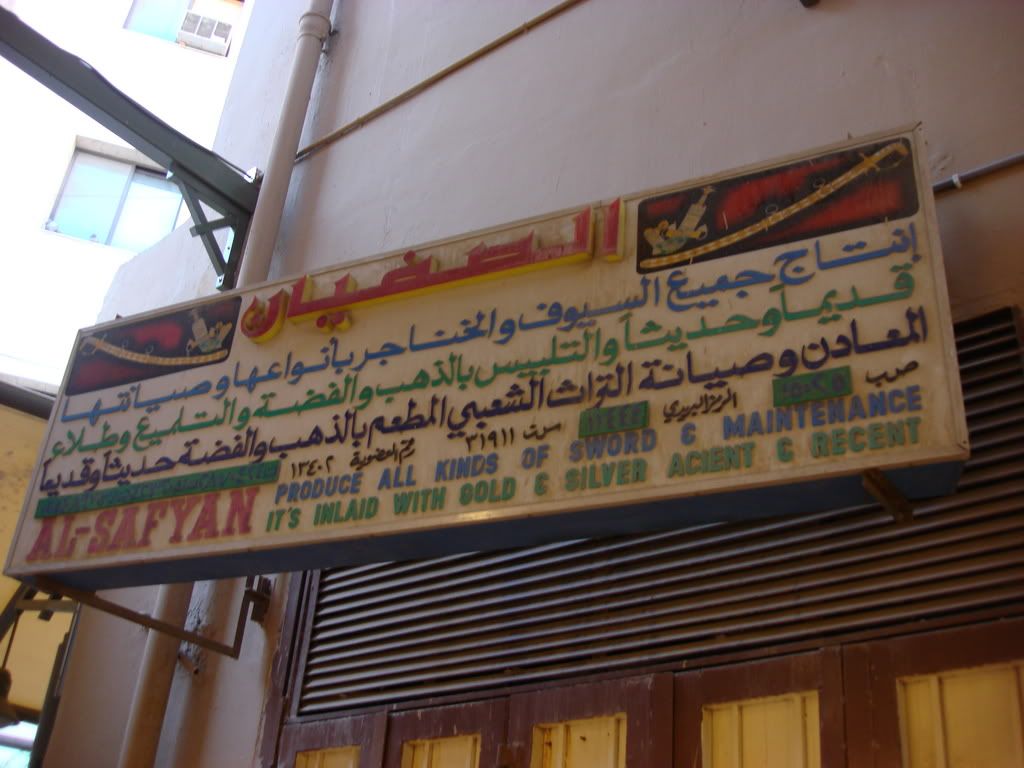 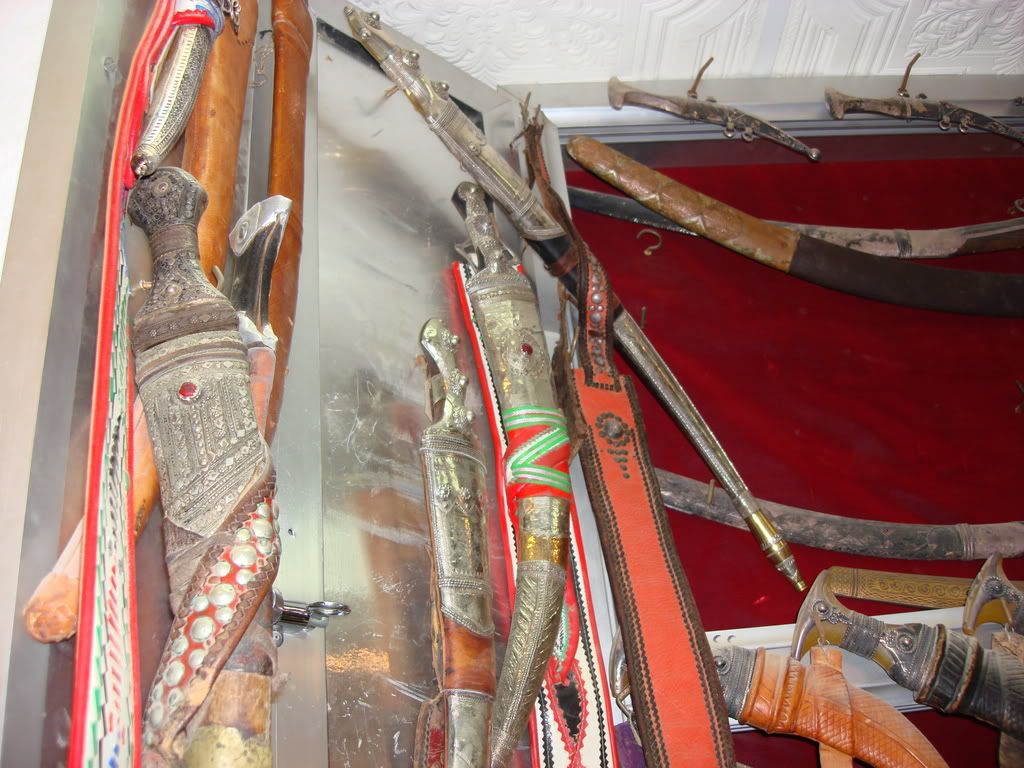 His magnifying glass, with which he identifies giraffe, from rhino, from cattle horn, and between ivory and bone 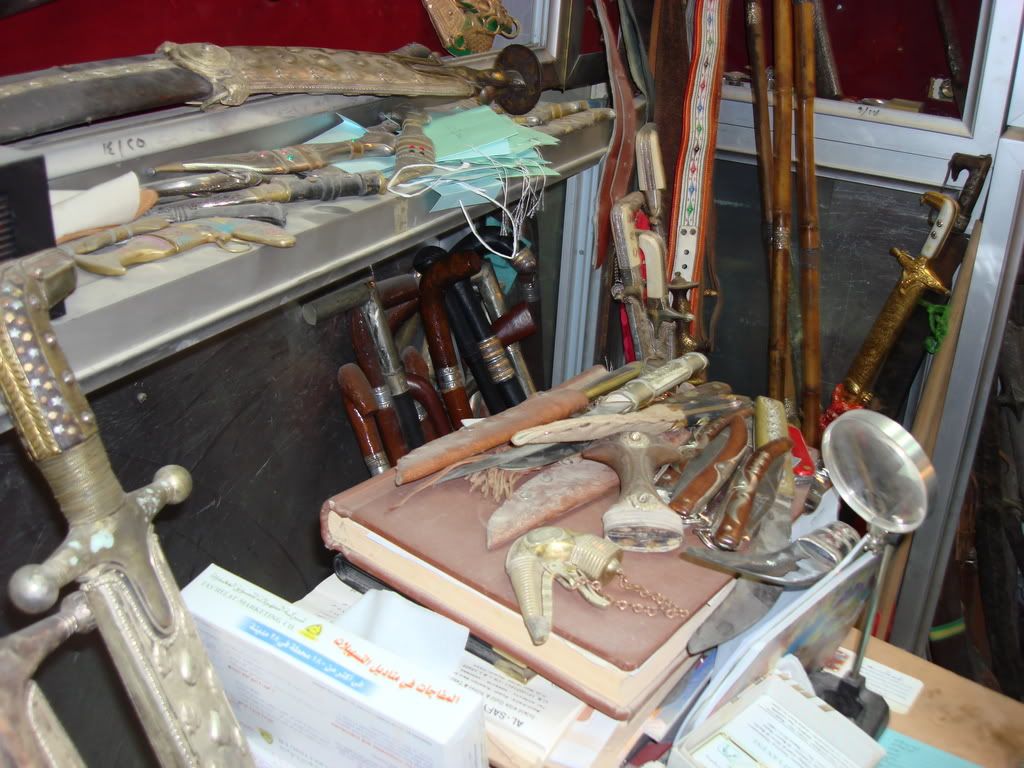 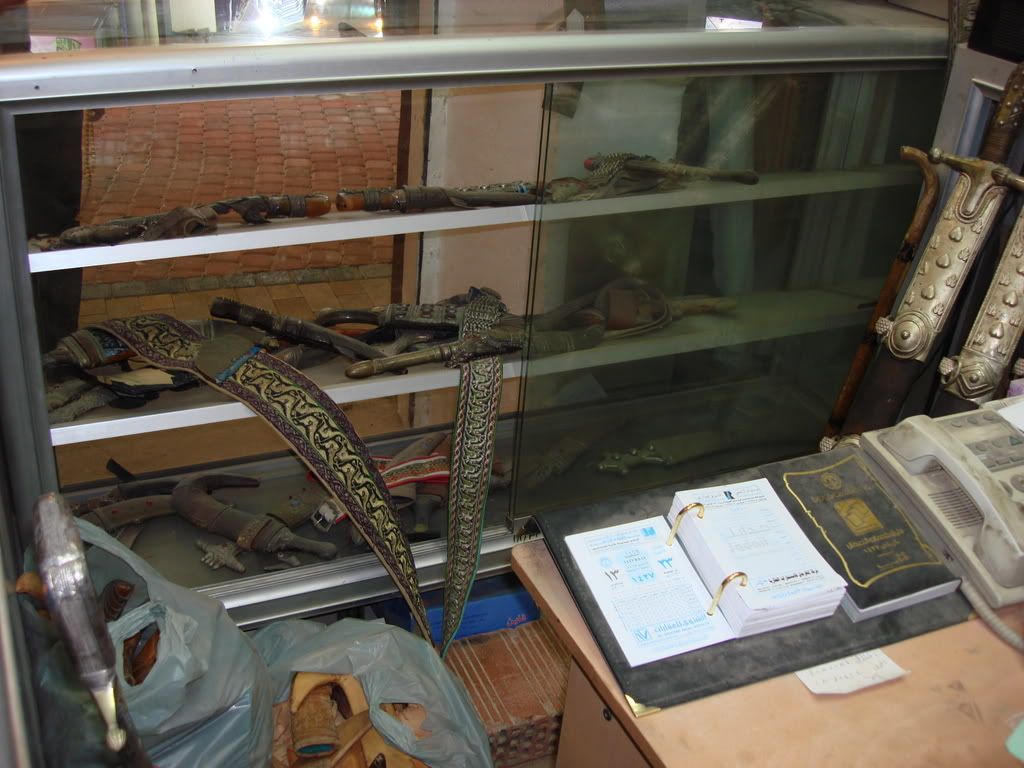 A huge omani jambiya, for display only 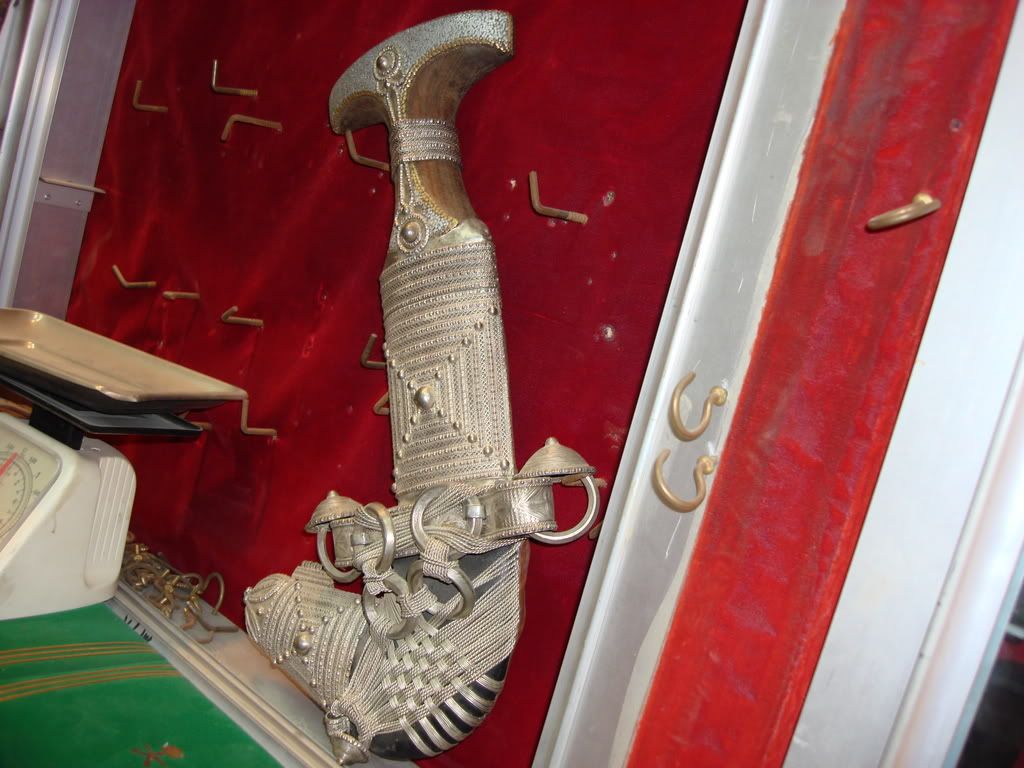
|
|
|

|
|
|
#11 |
|
Member
Join Date: Jun 2006
Location: Arabia
Posts: 278
|
Ghaddaras in the corner. The tulwar you see has the resharpened and fatigued blade, yet it is still, more expensive than most of the swords in the shop.
 Spare hilts, of many types 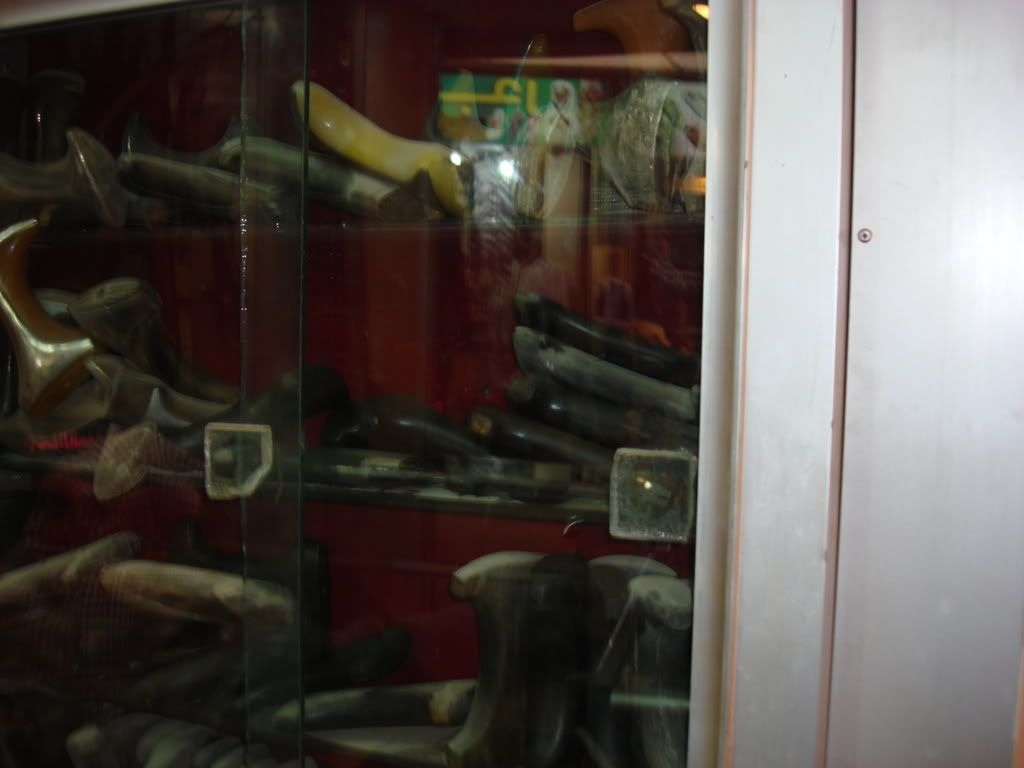 The tulwar with the red velvet scabbard you see, is the most expensive sword in the shop, at $12000. 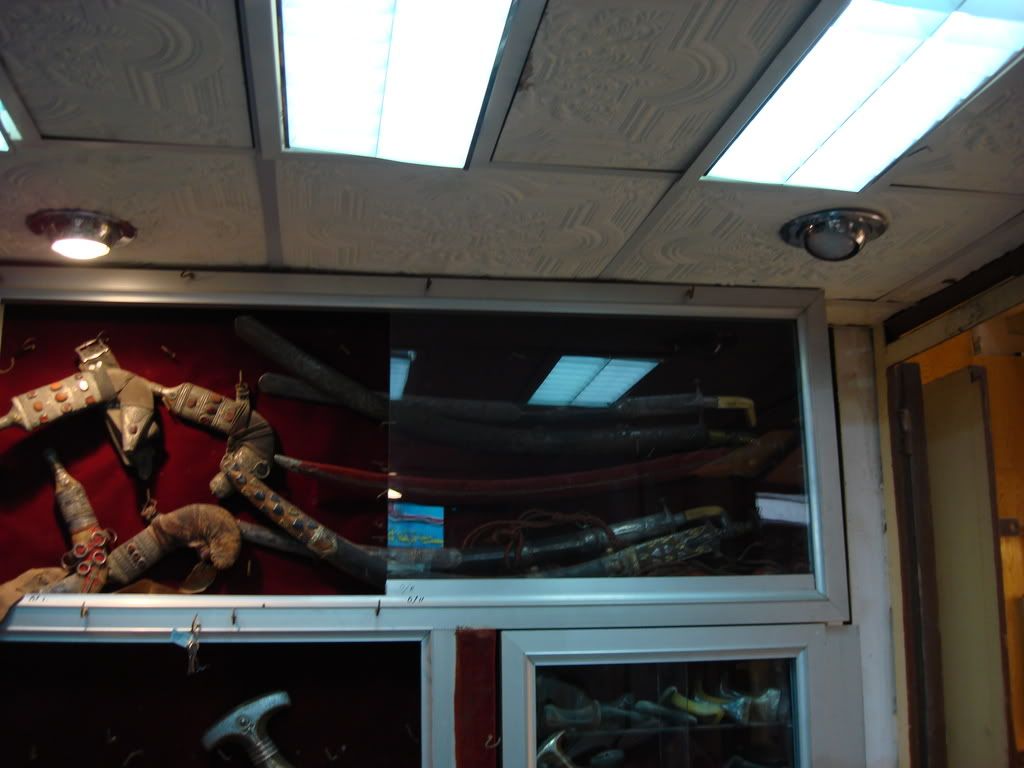 Newly made persian tridents, complete, with the cartouche too! 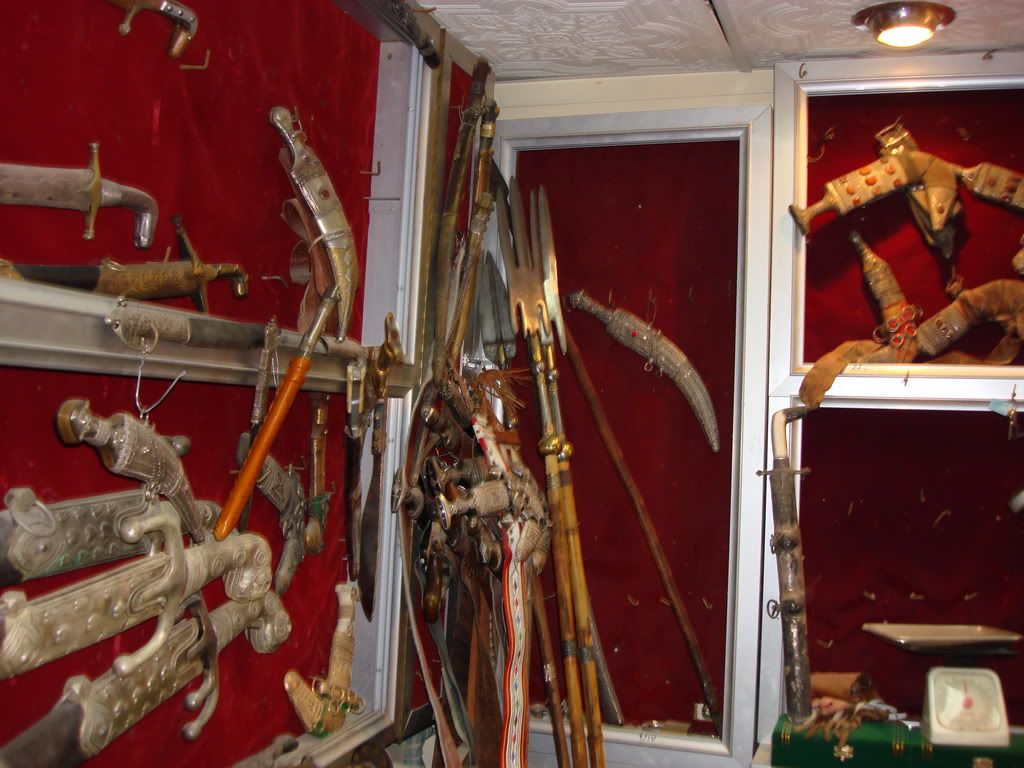 The four swords on the top all have persian wootz blades, with Syrian or Nejdi mounts, the fourh and bottom one has newly made syrian fittings. They all have persian wootz blades, and all run for $1800-$1200. Abu Bandar generally considers persian wootz to be inferior to Indian wootz, which he highly praises, even if the blade has been resharpened alot and fatigued. He also places Clauberg blades on top of Persian wootz in quality!!! Please ignore the gigantic swords that appear in the pic, they're nothing but a bunch of newly made syrian wallhangers. 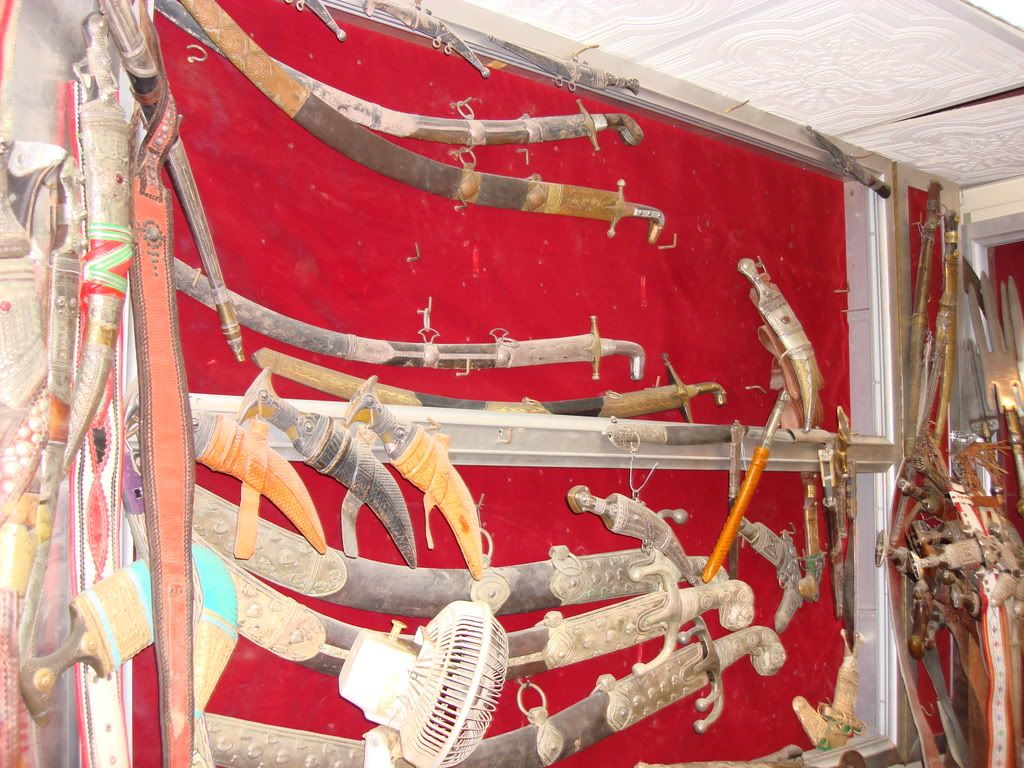
Last edited by S.Al-Anizi; 21st January 2007 at 12:47 AM. |
|
|

|
|
|
#12 |
|
Member
Join Date: Jun 2006
Location: Arabia
Posts: 278
|
This saif, or Gurda as its properly called (a straight bladed sword is called a gurda), is one of the most expensive ($9400) , and the most beautiful sword ive seen in my trip. It has an almost 500 years old, single edged English blade, marked on the spine "England 1510", and has a crown on the forte which I forgot to capture. The fittings are of pure gold, camel hide, and turquoise. On a first glance, it looked heavy and unweildy, but when I handled it, it was the best handling sword Ive held, very light, and very swift, but with good presence. I would really appreciate it if someone could ID that blade for me.
Tip is cross hatched 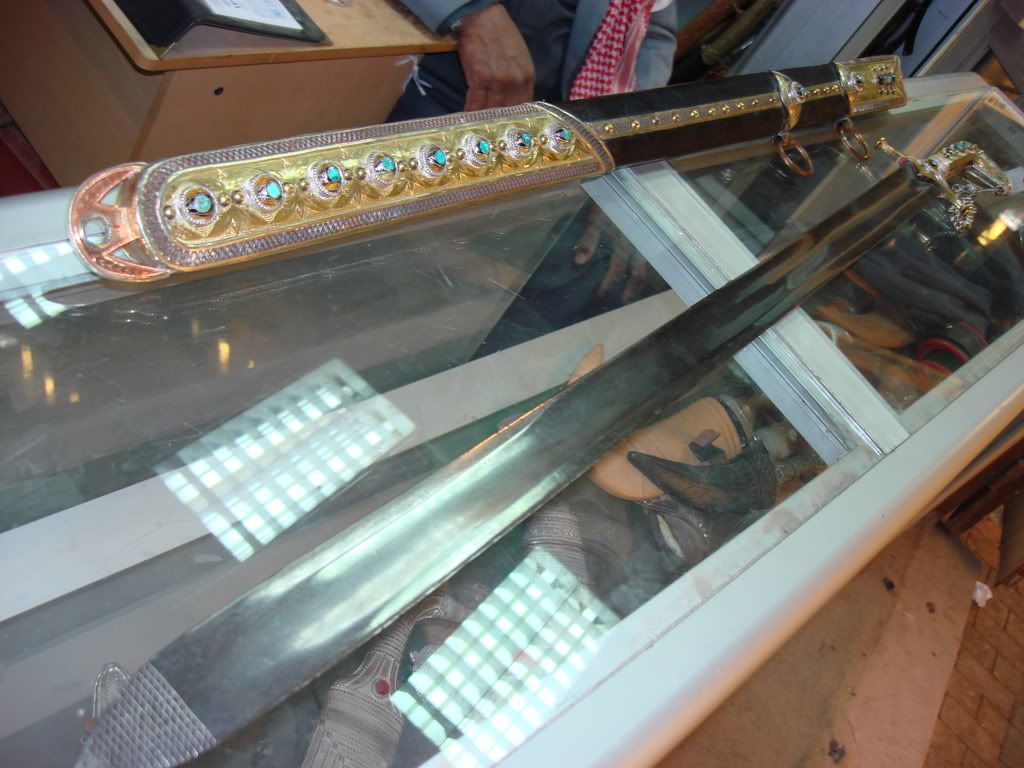 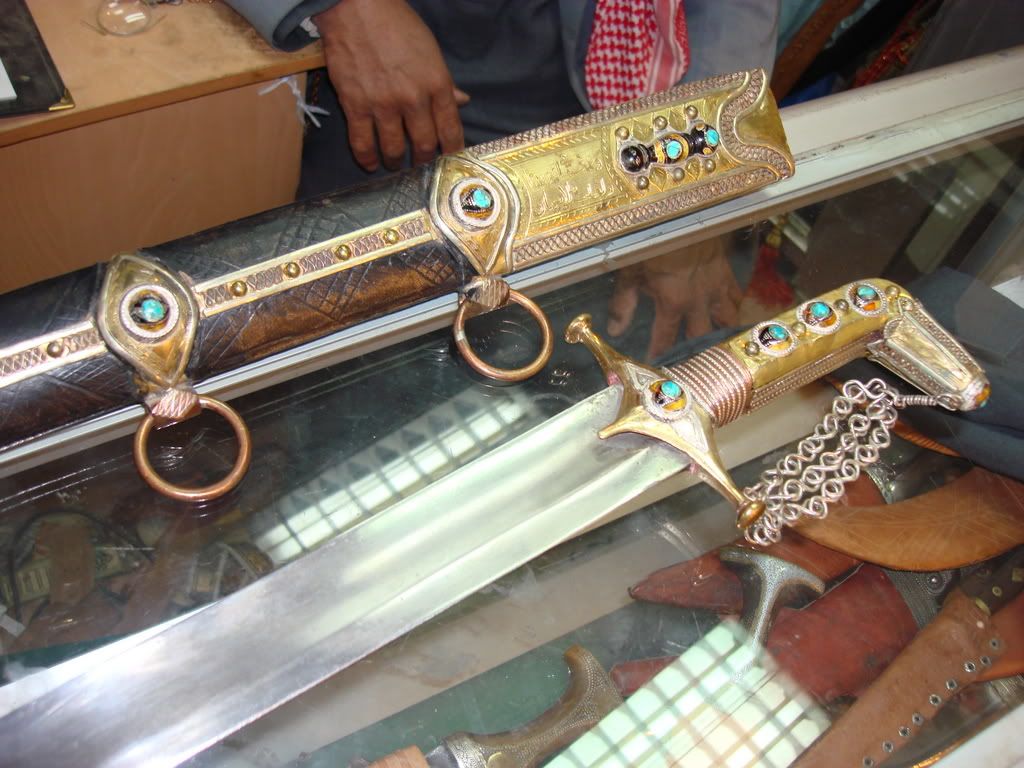 Closeup of hilt 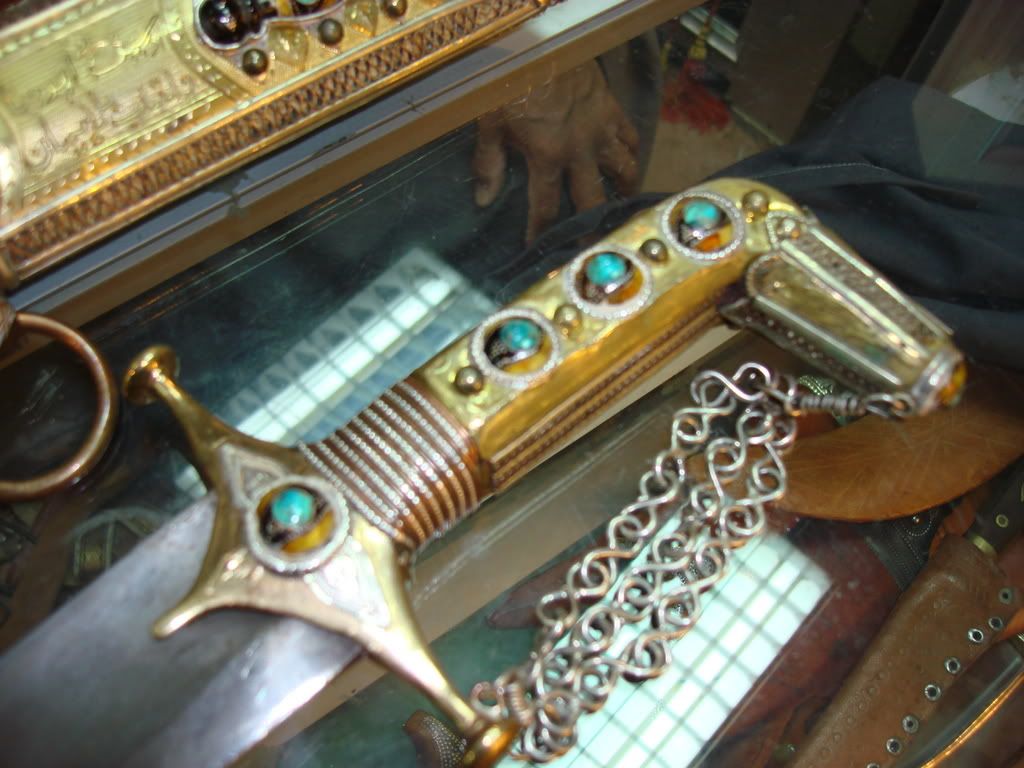 Sorry if that didnt turn out so well, but it says "England 1510" 
|
|
|

|
|
|
#13 |
|
Member
Join Date: Jun 2006
Location: Arabia
Posts: 278
|
A mizraag that I found in the shop. I handled it, and it seemed well suited for its purpose, very light, and well balanced forwards, well suited for being thrown. Despite its crude appearance, its very useful.
 Closeup of the spike 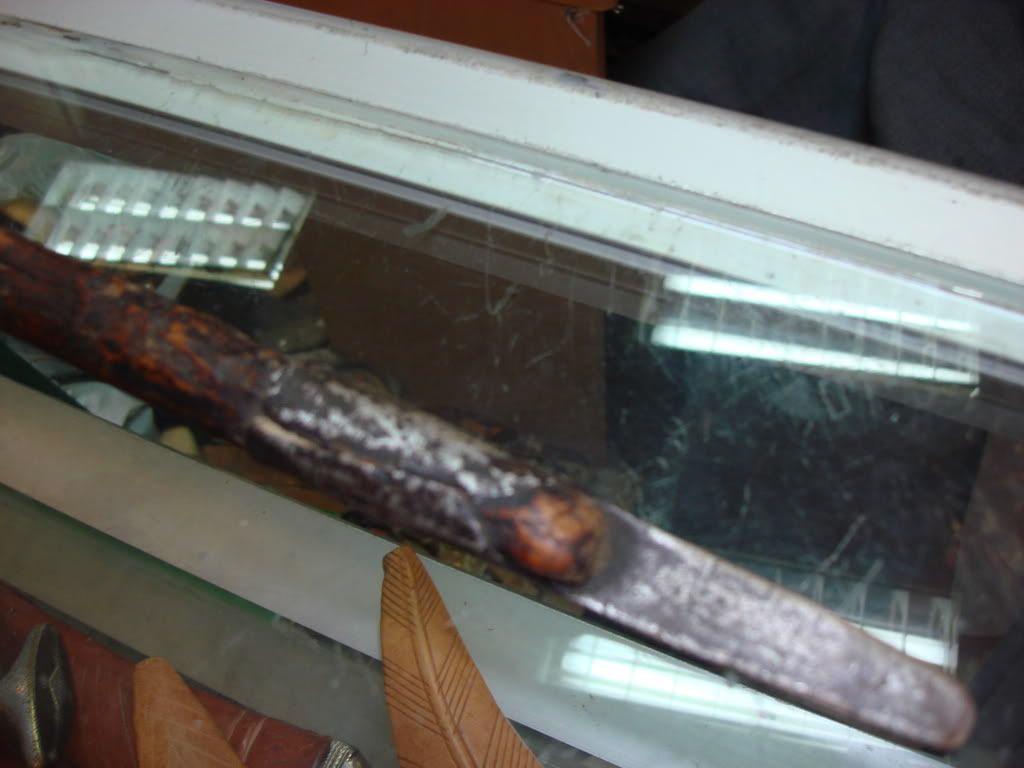 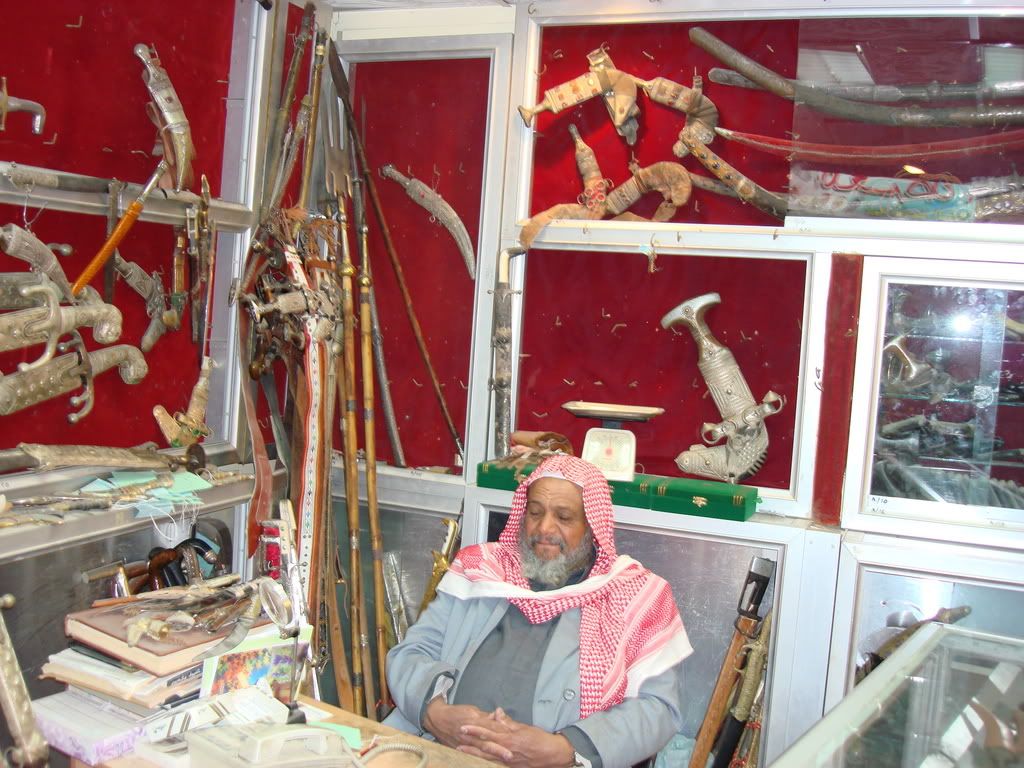
|
|
|

|
|
|
#14 |
|
Member
Join Date: Jun 2006
Location: Arabia
Posts: 278
|
I had learned alot from this old man. First, that not all wootz is great as it sounds, some biyaadh (lit. 'whiteness', non-wootz blades) such as Wilhelm Clauberg blades, which he calls "Abu Askiri" (lit. Bearer of the Soldier), exceed in quality some zaraag (lit. blueness), wootz blades. He also generalises, that Indian wootz, is much better than persian wootz, even the famed assadollah blades, which he has many of. He actually offered me a persian wootz, slender kilic blade, with a very nice curve and yelman, very nice pattern, and old Syrian fittings, for $1200, when he wouldnt sell a clauberg blade for less than $1500. He also is under the impression that clauberg blades are 'Anglais', not German. I also learned from him, that he puts 90% of the price, on the blade itself, the fittings and their material being only a trifle, and the the blade and its quality is the most important thing. I also asked him about the provenance of the many arab karabellas that I saw in the souk, and in his shop, he told me that these were mainly produced in Najran, but also at San'aa. While handling that purple tulwar, it occured to me to ask him why he thinks they have smaller hilts, he replied by saying that the Indians have smaller hands than us. Terminology, he helped me with that too, swords with persian blades that have an extreme curve, are called 'hilali' (crescent shaped), swords with straight blades, are called 'gurda' (is that a hungarian word?), and swords, not falling into these categories, are called saif. Of course, to a person not knowledged in swords, every sword is a saif. Newly uncovered facts, not listed in Elgoods book
 I also asked about the issue of polish, and that most blades coming out of arabia are buffed. He told me that he does not use a buffing wheel, rather, he uses special polishing stones, sandpaper, oil, and alot of elbow grease for polishing blades. He says, unfortunately, most people like to go the easy way, not willing to pay for a good polish job, and take their old, valuable blades to a blacksmith, who would buff them for a very cheap price. When I asked what he recommends for polishing wootz, he says that people used a a special kind of sand, mixed with spices, called 'narmahan', which, when rubbed against the blade, would bring out the pattern, without causing any oxidisation. When it comes to Jambiyas, he told me that in Oman, two centres where the main ones in producing them, one was Muscat, the other, being the settlement at the Buraimi oasis, which included a large number of bladesmiths and metalworkers. The finest silver and goldwork being the 'Ibri (arabic for hebrew), nothing comes close. Finally, I asked him about the many new, and not-so-old swords coming out of Saudi Arabia, usually having silver fittings and a nice blade, like the ones eftihis and I own, of which I say MANY at the souk. He told me that a large factory at Ta'if, produces those in huge quantities, mass produced, but hand assembled of course. He told me that the older ones, like 10 years ago or more, were of very good quality, having forged blades (spring steel) , heat treated, and bone, or sometimes even ivory hilts, depending on the blade (if it were new or old). Maria Theresa Thalers were used to make the silver fittings. The newer ones, however, are of display quality. Having machine milled, stock removal blades, plastic hilt slabs, and silver mixed with nickel. They have two uses, either for display, or for sword dances. They however, are still way better than the stuff coming out of Syria, still having steel blades. Last edited by S.Al-Anizi; 22nd January 2007 at 12:58 AM. |
|
|

|
|
|
#15 |
|
Member
Join Date: Apr 2005
Location: dc
Posts: 271
|
تلك هي جميلة السيوف وجانبياه. شكرا
Thanks for the great photos. I've been studying Arabic, now I have to start planning a trip. |
|
|

|
|
|
#16 | |
|
Member
Join Date: Jun 2006
Location: Arabia
Posts: 278
|
Quote:
You're always welcome Mike  You've still got to work on your arabic You've still got to work on your arabic  , but it makes sense. Of course, without knowing how to speak or having a translator with you, its useless to go there. Check out the second last pic from the 3rd post, thats a kattara you havent added to your unique connection , but it makes sense. Of course, without knowing how to speak or having a translator with you, its useless to go there. Check out the second last pic from the 3rd post, thats a kattara you havent added to your unique connection 
|
|
|
|

|
|
|
#17 |
|
Member
Join Date: Mar 2005
Location: USA Georgia
Posts: 1,599
|
Great looking pieces! I want to go there!
  
|
|
|

|
|
|
#18 |
|
Member
Join Date: Jun 2006
Location: Arabia
Posts: 278
|
So, no one knows anything about that English blade? anyone?
|
|
|

|
|
|
#19 |
|
Member
Join Date: May 2005
Location: Merseyside, UK
Posts: 222
|
Thanks for sharing your wonderful pictures.
 Do any of the shops in the bazaar sell shields or armour (i.e. mail shirts, bazubands or helmets?) On the subject of the sword blade, I have to say it looks pretty new for a 500 year old blade, but I'm no expert. The following forums might give you some answers: http://forums.swordforum.com/forumdisplay.php?f=11 http://forums.swordforum.com/forumdisplay.php?f=13 http://www.myarmoury.com/talk/viewforum.php?f=1 |
|
|

|
|
|
#20 | |
|
Member
Join Date: Jun 2006
Location: Arabia
Posts: 278
|
Quote:
 I think I saw some mail shirts around, but I did not see any bazubands. Im sure that al-ahaidib's shop has everything, including armour. If you havent heard, I was banned from swordforum a while ago, but I shall try on myarmoury 
|
|
|
|

|
|
|
#21 |
|
Member
Join Date: Dec 2004
Location: What is still UK
Posts: 5,935
|
There must be Tudor ie 1500s script and engraving to check against this blade on the internet. The way it is on the blade does look as if it is a little latter.
What if the 1510 is an Islamic number, would it then be England 2003. The way England is engraved does look rather modern. Last edited by Tim Simmons; 21st January 2007 at 01:19 PM. |
|
|

|
|
|
#22 | |
|
Member
Join Date: Jun 2006
Location: Arabia
Posts: 278
|
Quote:

|
|
|
|

|
|
|
#23 |
|
Member
Join Date: Dec 2004
Location: What is still UK
Posts: 5,935
|
Okay that rule that out. I did not really under stand what I was doing on a calendar conversion site. The script and number not do look like they were done by a Tudor hand. Compere here and these are informal letters.
http://images.google.com/imgres?imgu...WE:en%26sa%3DG Last edited by Tim Simmons; 21st January 2007 at 06:45 PM. |
|
|

|
|
|
#24 |
|
Member
Join Date: Dec 2004
Location: What is still UK
Posts: 5,935
|
When I have time latter this evening I will scan some pictures of engraved lettering on 15-18th century blades.
|
|
|

|
|
|
#25 | |
|
Member
Join Date: Jun 2006
Location: Arabia
Posts: 278
|
Quote:
although it is less cursive. |
|
|
|

|
|
|
#26 |
|
Member
Join Date: Jun 2005
Location: Tebbetts, Missouri, USA
Posts: 49
|
Thank you for your pictures and comment.
Are you of the opinion that in the Arab world swordmaking is going the way of Toledo and Thailand where once wonderfull and fantastic weapons are being driven out of the marketplace by ill-ballanced, ugly objects unfit even for gardening? |
|
|

|
|
|
#27 |
|
Member
Join Date: Dec 2004
Location: What is still UK
Posts: 5,935
|
The ENGLAND 1510 sword looks the spitting image of the 1796 heavy cavalry pattern sword. This sword was in service for 30 years according to Swords of the British Army, The Regulation Patterns 1788 to 1914. Pictures of engraved lettering to follow.

|
|
|

|
|
|
#28 |
|
Member
Join Date: Dec 2004
Location: What is still UK
Posts: 5,935
|
I am having trouble finding pictures of British sword blades earlier than the late 1600s with English engraving on the back. These two pics from the late 1700s help show a more old style especially the numbers. I may well be terribly wrong but to me the engraving looks more modern on the 1510 sword. Clean and lacking any wear. If it is a 1796 sword than it is no wonder it feels good and it has been made into great looking weapon.
 
|
|
|

|
|
|
#29 |
|
Member
Join Date: Mar 2006
Location: Room 101, Glos. UK
Posts: 4,262
|
Wow!
I spent a couple days in riyadh back in '95 when i had to get my visa for the UK, but never had a chance to go to the souk. i was working for M. Al-Mojil's construction co., out of Dammam at the time, after having worked for aramco in dhahran for 10 years. never saw any such fine specimens in the shops in al-khobar or dammam while i was there, saw a lot of expensive new swords in silver & gold mounts/scabbards but they never impressed me much, looked like 'dancing' swords, not real battle blades. i was not as knowledgeable then either.... thanks, shukran, siddiqi, for showing those to us. |
|
|

|
|
|
#30 | |
|
Member
Join Date: Jun 2006
Location: Arabia
Posts: 278
|
Quote:
There never were any real bladesmithing tradition in arabia, except for mounting foreign blades with local hilts and scabbards, or so we may think right now. The area of arab arms and armour is probably the least explored in the field of arms and armour. If you would mean quality work, with old blades such as these, or the swords coming out of Ta'if, completely new, I would say yes, cheap Syrian junk is taking over the market. That is not to say that all newly made syrian stuff is bad, some are worthy being called swords. Its just that the bad stuff is driving quality out of the market. |
|
|
|

|
 |
|
|